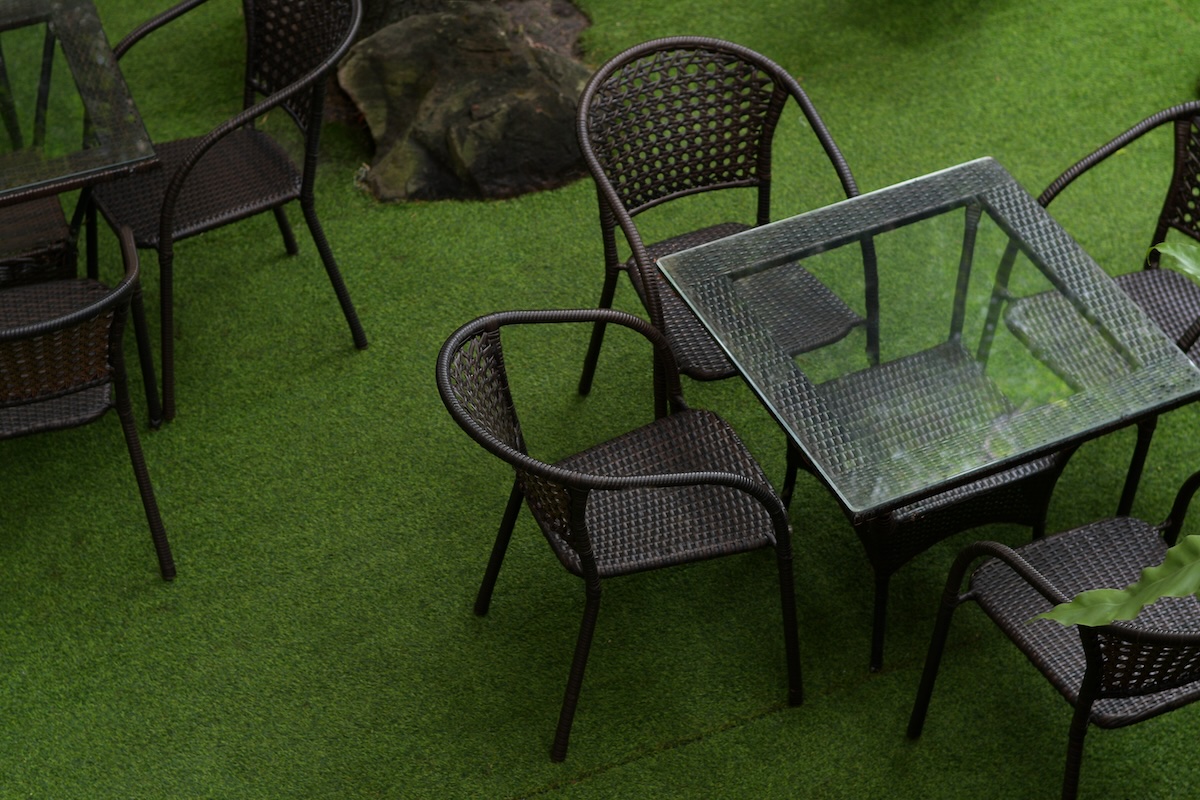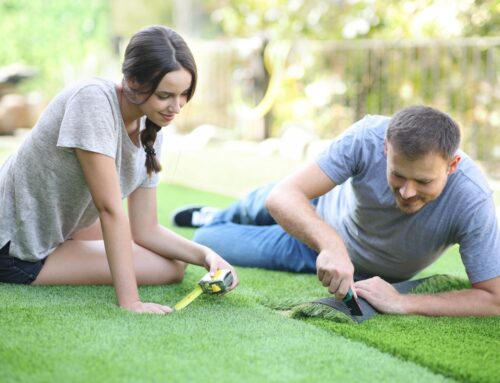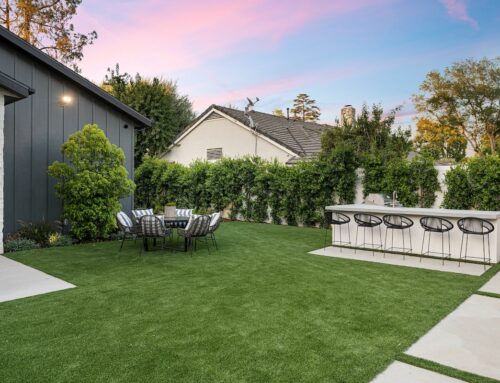Last Updated on April 29, 2025 by ReTurf
If you’re thinking about using artificial turf and you care about waste, sustainability, or just getting a good deal, you’ve probably run into terms like “recycled turf” and “recyclable turf.” They sound similar, but they’re talking about two pretty different things. Let’s break it all down in plain English, so you can make the right call for your project.
Recycled vs Recyclable vs Used Turf
Most of the time when people say they’re looking for recycled artificial turf, what they’re actually looking for is used turf.
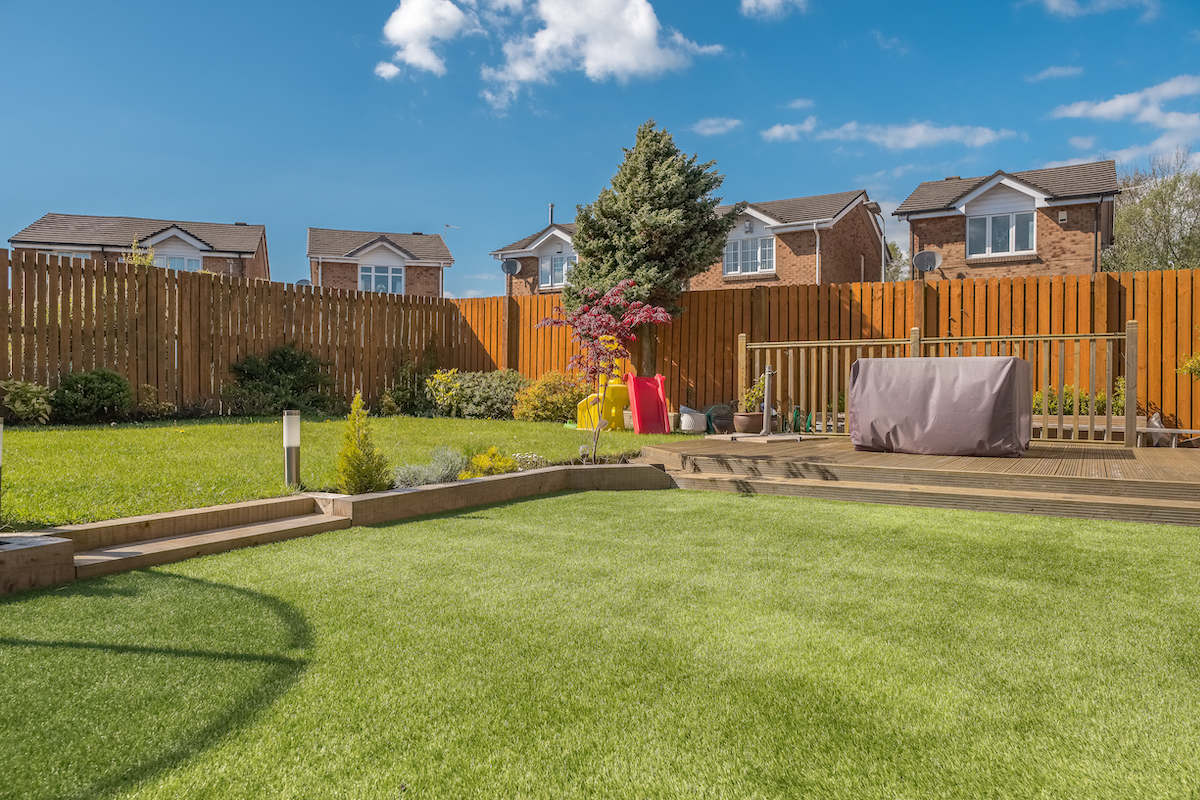
Here’s the distinction in simple terms:
- Recycled turf means the turf has been pulled up and processed in some way — it might be cleaned, remanufactured, or even ground down for new products.
- Used, repurposed, or reclaimed turf means the turf has been pulled up and resold as-is. No real processing, just giving the turf a second home — like from a sports field, stadium, or large landscaping project.
Used, repurposed, or reclaimed turf (these terms get thrown around a lot) generally means turf that’s been taken up from somewhere else and resold as-is. No recycling or complex processing involved. It’s the same turf—maybe from a sports field, stadium, or big landscaping project—just finding a second home.
A lot of this turf is top-tier material, originally made for high-end athletic fields, stadiums, or large-scale commercial installs. That means it was built tough to begin with—designed to handle serious foot traffic, heavy use, and all kinds of weather. It might have a few seams or some cosmetic wear, and sometimes you’ll see field markings (though unmarked options are available from some used turf suppliers too), but structurally, this stuff is built to last.
Recyclable turf is turf that’s designed to be recyclable at the end of its life. Unlike older turf systems that mix a bunch of different plastics and fillers, this stuff is made from more uniform, recyclable materials—so when it’s finally time to pull it up, it can actually be broken down and turned into something new instead of going straight to a landfill.
Big difference: recyclable turf is usually new when you buy it. So you’re getting fresh product, clean install, and full lifespan ahead of you. That said, don’t count out used turf either: because a lot of it was originally installed on high-performance fields, it’s built tough from the start and still has plenty of life left, making it a smart, cost-effective choice for re-use projects.
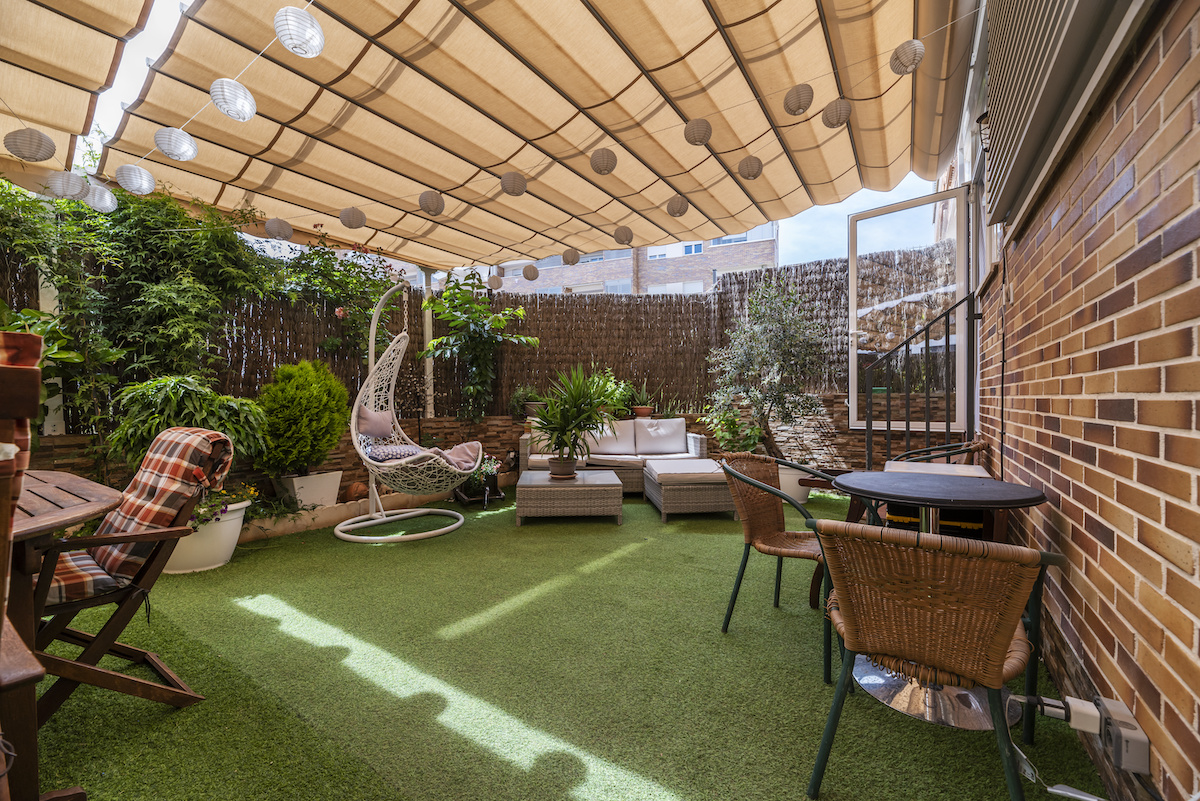
So, quick recap:
- Recycled = processed after use
- Recyclable = can be recycled later
- Used/repurposed = pulled up and resold without changing much
Why It Matters
To reiterate, when most folks start looking around for “recycled turf,” what they’re usually after is used turf — good turf that’s been pulled up from a field or a big commercial job and is still in decent shape to get a second life. Technically “recycled” would mean it has been processed somehow — cleaned, broken down, maybe even turned into filler material. But a lot of the time, that’s not what people are hunting for. They just want something sustainable, affordable, and ready to roll out.
If you’re trying to save money, and you’re okay with a little character—maybe a seam here or there, a scuff, or some leftover lines from its first life—used turf is hands-down the most affordable way to go.
Now, it’s important to be aware that not all used turf has field markings. You can find marked turf (where you’ll still see at least the edges of field markings like logos or yard lines) and unmarked used turf (where the lines have either been cut around, faded out, or were never there to begin with).

If you’re covering a dog run, batting cage, or completing another project where “perfectly new” isn’t the goal — used turf can stretch your budget a long way without sacrificing function.
On the flip side, if you’re building something new and want to be smart about the future — thinking ahead to when it’s time to replace it — going with a recyclable turf is the way to go. It costs a little more upfront, sure, but you’re setting yourself up for an easier, cleaner disposal when the time comes.
Bottom line: each type of turf solves a different kind of problem. It just comes down to matching it to your project, your budget, and your priorities.
Why Artificial Turf Is Hard to Recycle
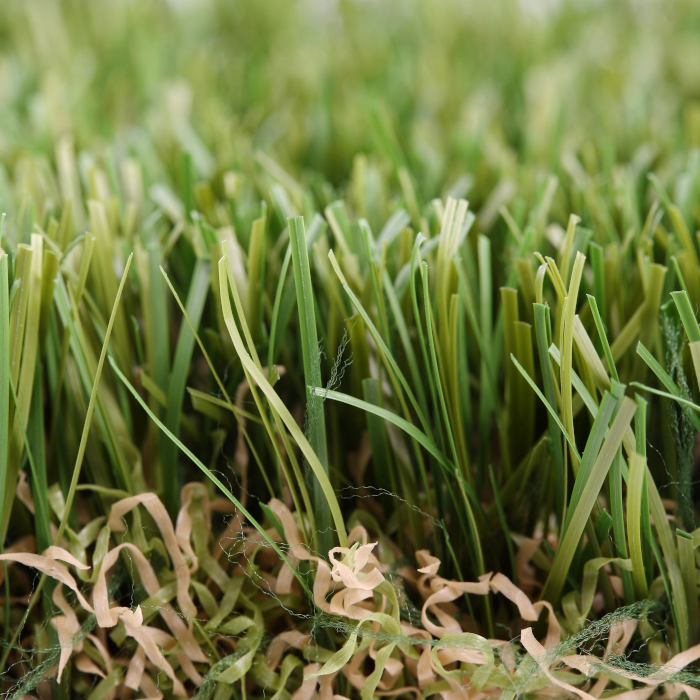
Turf might look simple when it’s rolled out in your yard or on a sports field, but “under the hood,” it can actually be pretty complex. That’s part of what makes the best quality artificial turf so realistic and durable—but it’s also what makes recycling it such a headache.
You can think of the structure of synthetic grass like a layered cake—except instead of chocolate and frosting, it’s stacked with different types of plastic, rubber, and filler:
The “Grass” Layer
Right on top, you’ve got the green part—the grass blades. These are plastic fibers, usually made from:
- Polyethylene – the most common, soft and flexible.
- Polypropylene – stiffer, sometimes used for lower-cost options.
- Nylon – super durable, but more expensive.
Sometimes there’s even a little thatching mixed in underneath the blades. That’s the curly fibers that sit lower in the turf and help mimic the look of dead grass or the tangled thatch layer you’d find in a real lawn. This layer gives higher-quality turf a fuller, more realistic look.
Thatching might seem like a small detail at first, but it makes a huge difference in how the turf looks and feels. A thatch layer adds visual depth, gives the blades a more natural stand, and helps the turf look a lot less “plastic” from a distance. It also adds a bit of cushioning and support, helping the upright blades spring back when they’re stepped on.
Basically, it’s a feature that makes fake grass look less fake—and it’s one more layer that adds complexity when you’re trying to recycle or repurpose turf later on.
The Backing Layers
Beneath the grass fibers are one or two backing layers that hold everything together. These are usually made from more plastic—things like:
- Polyurethane
- Urethane (especially in American-made turf)
- Latex or polypropylene
The first layer (the primary backing), is what the blades are stitched or tufted into. Then there’s usually a secondary backing, which gets coated or bonded to the first to lock everything in place. Together, they create a solid, durable base that can handle years of use without the blades pulling out or shifting around.
These backing layers are also what give turf its dimensional stability—in other words, they help keep it from stretching, warping, or sagging over time. That’s crucial for a clean, professional install that doesn’t buckle or ripple after a few seasons of sun and rain.
But when it comes time to recycle? All these layers—bonded together with glue, heat, or chemical coatings—turn into a real puzzle.

They’re not just different materials, they’re fused, which means you can’t easily separate them without specialized equipment or a lot of manual labor. That’s one of the biggest reasons why turf recycling still hasn’t caught up to turf installation in terms of ease or scale.
The Infill
After installation, infill gets added between the grass blades. This keeps them upright and adds weight to keep the turf stable. Infill can be made from:
- Crumb rubber (recycled tires)
- Silica sand
- TPE/TPO (thermoplastic elastomers or olefins)
- Cork, coconut husk, or walnut shells (for eco-friendly installs)
Some setups mix multiple infill types to get the best blend of softness, bounce, or cooling.
Extra Layers Beneath the Turf
In certain installs—like playgrounds or premium athletic fields—you’ll find even more going on below the turf:
- Shock pads made from EVA foam or polyurethane
- Drainage layers made of molded plastic grids or mats
- Weed barriers or geotextile fabric
Each of these components serves a purpose, but from a recycling standpoint? It’s a mess. You’ve got dozens of different materials—some bonded together with adhesives, others filled with dirt, organic matter, or even mold depending on how long the turf’s been down.
So What’s the Problem?
All those layers make synthetic grass very difficult to recycle. Most recycling centers aren’t set up to handle multi-material products like this. You can’t just toss the whole thing into a shredder and turn it into new turf. First, you’d need to:
- Separate each layer and type of material
- Remove all the infill
- Clean out dirt, plant debris, and whatever else got packed in over the years
That’s a lot of labor, and unless the turf was built with recycling in mind from the start (like 100% recyclable Tempo Turf), it’s usually not worth the effort for most recyclers. That’s why a lot of artificial turf—especially from older sports fields and commercial projects—unfortunately ends up in the landfill, even if parts of it technically could be recycled.
Pros and Cons to Think About
Recycled (Used) Turf
Pros:
- Cheaper than buying brand-new
- Keeps material out of landfills
- Great for temporary installs, dog runs, batting cages, event flooring, and budget projects
Cons:
- Might have seams, markings, or some cosmetic wear
- May not be covered under a new warranty
- Not always clear if it’s truly “recycled” or just “used”
100% Recyclable Turf
Pros:
- Environmentally responsible choice for new installs
- Often higher-quality materials and construction
- Good long-term solution if you’re planning ahead
Cons:
- Costs more upfront
- Recycling at end-of-life still depends on local facilities and programs
Where to Get Recycled or Recyclable Turf
Now, if you’re ready to track some down, here’s the straight talk:
For recycled or used turf, you want to look at companies that specialize in reclaiming it from sports fields, stadiums, and big commercial projects. One of the best-known names in that space is ReTURF, well-known in the industry for pulling high-grade sports turf, making it available for reuse and a “second life” in landscaping, gyms, dog parks, and all sorts of projects. They offer both marked (lines still on it) and unmarked turf depending on what you need.
If you’re looking for recyclable new turf, ReTURF also exclusively distributes a product called Tempo Turf. It’s specifically engineered to be 100% recyclable when it reaches the end of its life. That means you can have a brand-new install today and feel confident that you’re not kicking the disposal problem down the road.
Keeping Good Turf Out of the Landfill
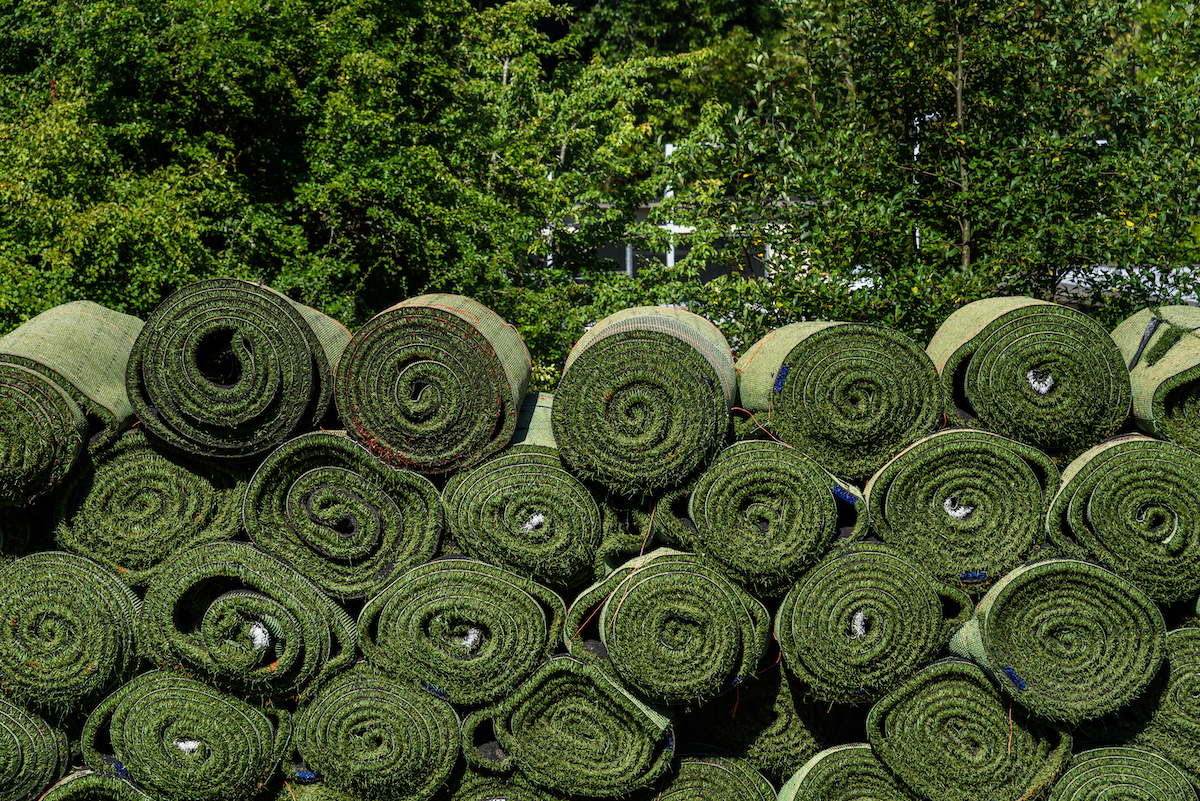
When a big stadium or sports field replaces its high-grade artificial grass, that stuff doesn’t just vanish. A lot of it is still in solid shape. Sure, it’s got some miles on it, but it’s extremely tough, durable, and perfectly usable for a ton of other applications.
The issue is, artificial turf is made of a mix of different plastics, backings, infill, and sometimes even organic layers. That makes it a pain to fully recycle in most places. So instead of going through that whole process, reusing it as-is makes a lot more sense—especially if it’s still got life left in it.
This is the kind of turf you’ll often see pulled from sports fields, cleaned up, rolled, and resold for all kinds of second lives—dog runs/parks/play areas, batting cages, construction site erosion control, even landscaping projects, putting greens, and more. It keeps the material out of the landfill, extends its useful life, and can cost a small fraction of what new turf costs.
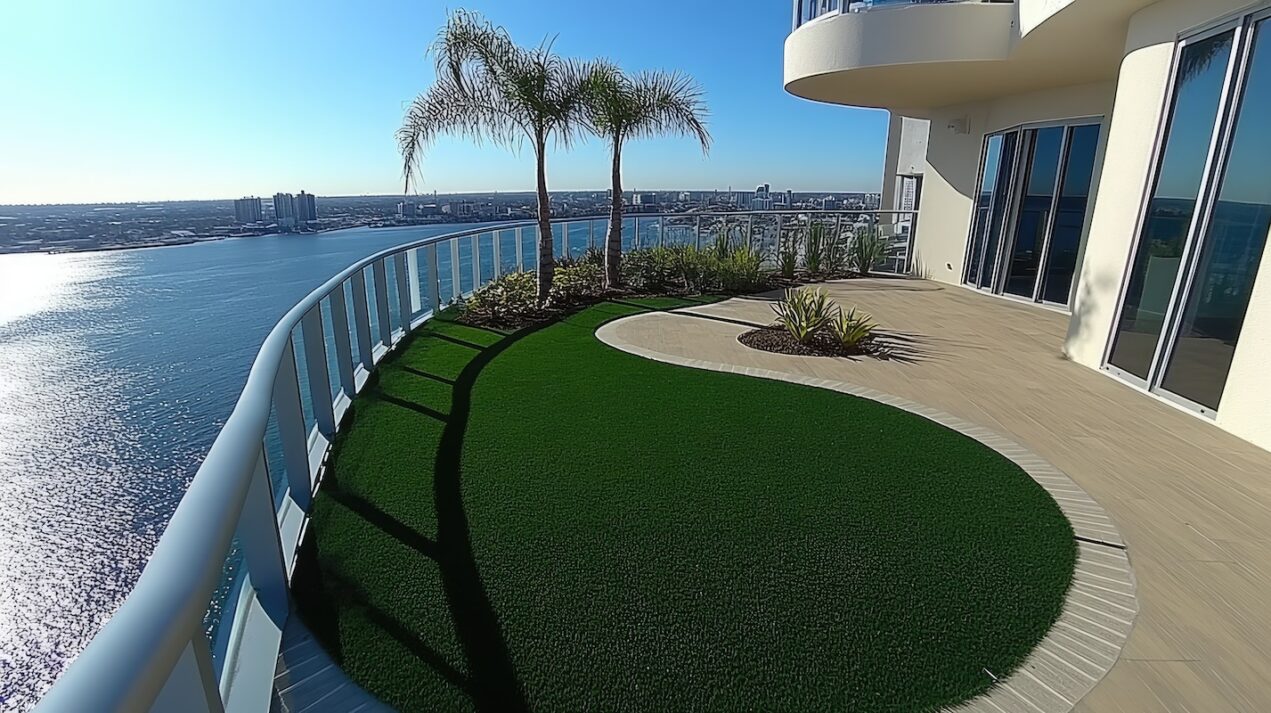
So while recycled and recyclable turf naturally get most of the attention when it comes to sustainability, repurposing used turf is also important. It’s a practical way to cut down on waste without overcomplicating the process.
Recycling Artificial Grass
One of the biggest changes we’re seeing in the synthetic grass industry is more interest in new turf products that are fully recyclable. Tempo Turf is a line of artificial turf made with Olefin fibers, a material that’s easier to recycle cleanly compared to older blends of plastic and rubber. It’s also made right here in the USA, so you’re getting high manufacturing standards and supporting domestic production.
With turf like this, you’re not just buying something that looks good today—you’re making a choice that’s more sustainable and easier to deal with at the end of its life. No guessing about where it’ll end up.
Final Thoughts
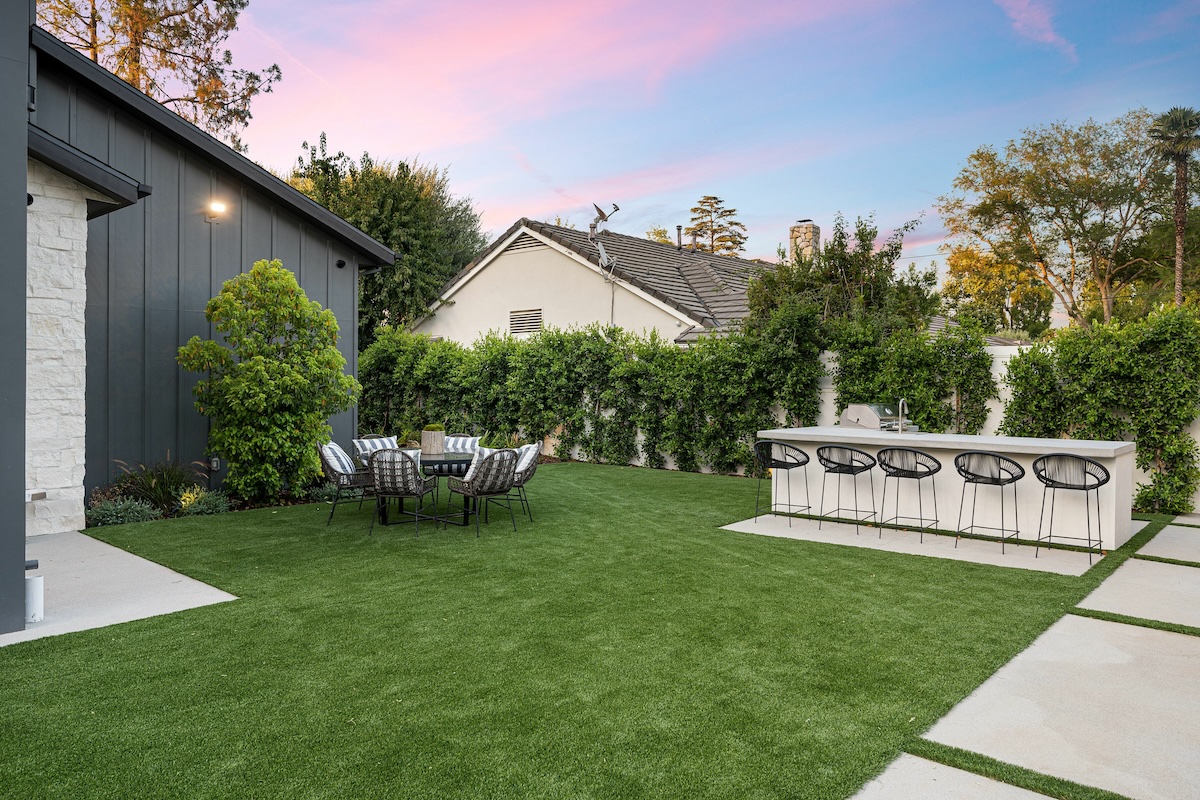
At the end of the day, whether you go with recyclable or recycled (used) artificial turf, it all comes down to what fits your needs, your budget, and your conscience. There’s no “wrong” choice here — just different tools for different jobs. And knowing the difference gives you the power to get it done right.
If you’re still weighing your options, it never hurts to reach out to a trusted synthetic grass supplier like ReTURF. Our artificial turf experts can steer you in the right direction based on what you’re trying to build. Click here to contact us.

